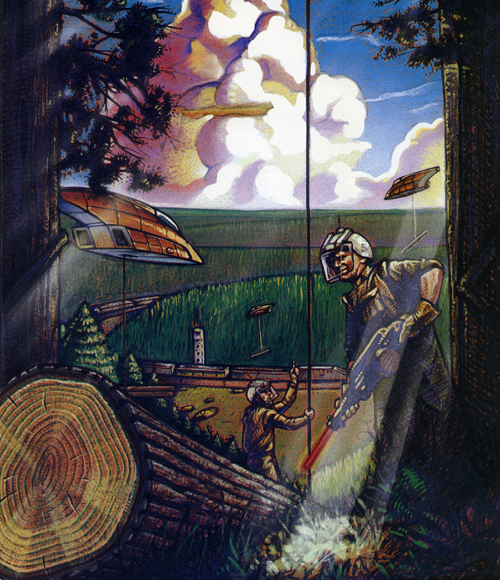Back to the Future, Part IV: “Where we’re logging, we don’t need roads”
The 25th anniversary of the iconic film franchise Back to the Future and the Blu-ray release of the trilogy on October 26 got us thinking about what forestry and logging were supposed to look like today as predicted by the best minds of the mid-20th century.
Some of those same minds had predicted that we would all be driving flying cars or have individual jetpacks to get to work. I don’t know about you but I’m still relying on the internal-combustion engine to get around. And that’s the problem with committing predictions of the future to paper. When organizations like the Forest History Society hold on to those documents, it’s easy to look back at them and assess how close to (or far from) the mark the writer was.

So let’s look at two sets of predictions. The image above isn’t a storyboard of a scene from Back to the Future. It’s a sketch of a forester treating a tree in 1975. Well, that was the prediction in 1955. For their film, People, Products and Progress: 1975, the U.S. Chamber of Commerce asked several organizations in 1955 to make future predictions about transportation, home life, and the workplace. To furnish a sequence on the lumber industry they called upon the National Lumber Manufacturers Association for help. The NLMA might have called their segment “Better Living through Chemicals.” They predicted foresters would use radioactive materials, hormones, and “other stimulating substances” to do things like pre-season the wood, make it fire resistant, and even change the color of the wood while the tree is still growing. Maybe they didn’t get all of that correct, but maybe what hasn’t come to pass still could through a combination of chemical injections and genetic modification.
The NLMA’s description of the sawmill of the future is fairly accurate in terms of using scanning equipment to assess the best way to cut a log. And although we aren’t yet cutting lumber with lasers it seems only a matter of time. They got the part right about helicopter logging, but using an ordinary helicopter isn’t as exciting to contemplate as using this contraption, a strange marriage of 19th– and 20th-century technologies.

This combination of multiple helicopters and blimp seemed like a good idea at the time. Alas, one of its flight tests failed in spectacular and tragic fashion and the program ended in 1986.
In 1980 the American Forest Foundation made a stab at predicting what the industry would look like in both 2010 and 2020. In 1980, to generate interest in National Forest Products Week, they issued what appears to be a press release that described working in 2010. For a separate project they produced a poster that made predictions about 2020. You’ll want to read the poster and the press release to see the subtle differences between the two in describing the future.
Some of it has already come to pass, like the use of handheld computers in the field and computers to aid in harvesting timber. The discussion of the “paperless society” in the press release is one worth revisiting in light of the internet and technology’s impact on how we read. (Are you reading this on your phone or a Kindle?) Interestingly, the artist wasn’t much of a visionary. You can clearly see the influence of Star Wars on the artist’s rendition of a logger. He looks like Luke Skywalker in his X-Wing fighter pilot uniform wielding a light saber—or is that a logging saber?
It’s interesting to note the emphasis on transportation in these various visions. More than a century ago Biltmore Estate forester Carl Schenck declared that “forestry was a problem of transportation” and that “good roads are needed to practice forestry!” Talk about back to the future! The vision of hovercraft lifting logs out of hard-to-access areas brings to mind the closing line from Back to the Future, when Doc Brown tells Marty, “Roads? Where we’re going, we don’t need roads.” If Doc were a forester, he might instead proclaim: “Roads? Where we’re logging, we don’t need roads.”
Will lasers be used to cleanly cut timber? Will robots load lumber onto hovercraft that haul lumber? Will trees be genetically engineered to produce different grains and colors? What are your predictions for the future of forests, wood utilization, and forest management? Leave them in the Comments area and we’ll come back in 25 or 30 years and see if you were right.
“Back to the Future” of logging and timber management
The 25th anniversary Blu-ray release of the film franchise Back to the Future got us thinking about what forestry and logging were supposed to look like now from the perspective of the mid 20th-century. Weren’t we all supposed to be driving flying cars or have individual jetpacks to get us to work? At least that’s what was predicted in the 1960s. And that’s the problem with committing predictions of the future to paper. When organizations like the Forest History Society hold on to those documents, it’s easy to look back at them and assess how close to (or far from) the mark the writer was.
So let’s look at two sets of predictions. The image above (or below) isn’t of a spaceman or of Doc Brown from the film. He’s a logger in 1975. Well, that was the prediction in 1955. For their film, People, Products and Progress: 1975, the U.S. Chamber of Commerce had asked several organizations to make predictions about transportation, home life, and the workplace. To furnish a sequence on the lumber industry they called on the National Lumber Manufacturers Association for help. The NLMA might have called their segment “Better Living through Chemicals.” They predicted foresters would use radioactive materials, hormones, and “other stimulating substances” to do things like pre-season the wood, make it fire resistant, and even change the color of the wood while the tree is still growing. So maybe they didn’t get all of that correct, but maybe what hasn’t come to pass could still through a combination of chemical injections and genetic modification. [link to book?]
The description of the sawmill of the future is fairly accurate in terms of using scanning equipment to assess the best way to cut a log. And although we aren’t yet cutting lumber with lasers it seems only a matter of time. They got the part right about helicopter logging, but using an ordinary helicopter isn’t as exciting as using this contraption, a strange marriage of 19th– and 20th-century technologies. It failed its one flight test in spectacular and tragic fashion.
In 1980 the American Forest Foundation made a stab at predicting what the industry would look like in 2010. Some of it has already come to pass, like the use of handheld computers in the field and computers to aid in harvesting timber. You can clearly see the influence of Star Wars on the artist’s rendition of a logger. He looks like Luke Skywalker in his X-Wing fighter pilot uniform wielding a light saber—or is that a logging saber?
It’s interesting to note the emphasis on transportation in these various visions. Biltmore Estate forester Carl Schenck declared more than a century ago that “forestry was a problem of transportation” and that “good roads are needed to practice forestry!” The vision of hovercraft lifting logs out of hard-to-access areas brings to mind a line from Back to the Future, when Doc Brown tells Marty, “Roads? Where we’re going, we don’t need roads.” If Doc were a forestry professor, he might instead proclaim: “Roads? Where we’re logging, we don’t need roads.”
What are your predictions for the future of forests, wood utilization, and forest management? Will lasers be used to cleanly cut timber? Will hovercraft be used to haul lumber?


